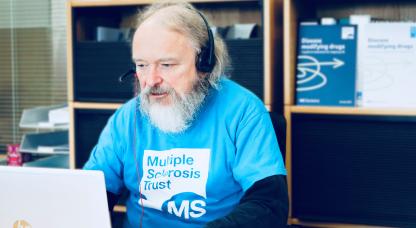Sometimes in multiple sclerosis people can experience difficulty swallowing (dysphagia). If swallowing becomes very difficult, then your doctor may feel that you need help to ensure you get proper nutrition and avoid chest infections that might be caused by food particles getting into your lungs (known as aspiration). You may be advised to have a feeding tube fitted, through a procedure called percutaneous endoscopic gastrostomy (PEG). Percutaneous means 'through the skin' and endoscopic refers to the use of a viewing tube into the stomach to observe and place the feeding tube correctly. Gastrostomy means an opening into the stomach.
With a PEG procedure, a small feeding tube is inserted directly into your stomach through the abdominal wall. The tube is fitted during a minor operation and can be hidden under clothes. A full balanced diet can be fed through the tube in liquid form, and the tube is sealed off when feeding is not taking place.
A PEG tube user can usually still take some fluids or food by mouth after the PEG has been put in place. The PEG tube generally lasts for 1-2 years, but can occasionally become blocked or damaged. The tubes can be readily replaced, or removed if no longer required. Care must be taken to keep the tube insertion site clean to avoid infection.
In order to have a PEG tube fitted, you will need a small operation. This is normally carried out under sedation rather than general anaesthetic, and is likely to take place at an Endoscopy department in hospital. The PEG procedure usually takes around 20 minutes, but you will need to relax for at least 30 minutes afterwards before moving. The effects of sedation vary, but you are likely to need rest and care for at least 24 hours after the procedure, as you may be sleepy.
To allow for a clear view, your stomach and first part of your intestine needs to be empty. Your hospital will advise you not to eat or drink for several hours beforehand. You will be given a sedative through a flexible needle in the back of your hand, so that you are relaxed and comfortable during the procedure. You will remain awake and still be able to respond to the people around you.
The doctor will pass a slim flexible tube with a light on (endoscope) through your mouth and into your gullet (oesophagus) until it reaches your stomach. After numbing your skin with a local anaesthetic, a small cut is made on the upper part of your abdomen. The gastrostomy tube is placed through this cut. The tube will not fall out because there is a bumper at the end of the tube inside the stomach. There is also a small plastic fixing plate on the outside of your abdomen, which lies close to the skin. This keeps the tube from sliding in and out of the opening. At the end of your tube there is a feeding adaptor which connects to a syringe or feeding set.
After you have recovered from sedation, you and your family or carers will be shown how to use and care for the feeding tube and insertion site (stoma). You should also be told what potential problems to look out for, and have numbers to call if you have problems. The PEG procedure may not be suitable for everyone with swallowing difficulties. For a short while after the procedure, the tube may feel uncomfortable, or you may have a mild sore throat.


